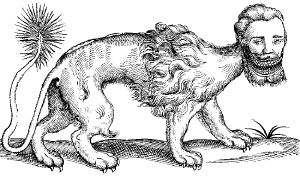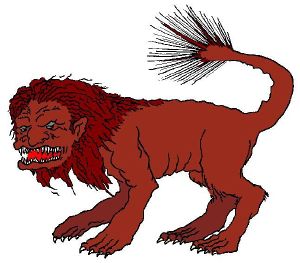Manticore
The manticore is a legendary creature of Central Asia, a kind of Chimera, that is sometimes said to be related to the Sphinx. Like many such beasts, it was often feared as being violent and feral, but it was not until the manticore was incorporated into European mythology during the Middle Ages that it came to be associated as an omen of evil.
Etymology
Originally, the term manticore came into the English language from the Latin mantichora, which was borrowed from the Greek mantikhoras. The Greek version of the word is actually an erroneous pronunciation of the original early Middle Persian martyaxwar, which translates as "man-eater" (martya being "man" and xwar- "to eat").[1]
Description
Although versions due occasionally differ, the generalities of the manticore's description seem to be that it has the head of a man often with horns, gray or blue eyes, three rows of iron shark-like teeth, and a loud, trumpet/pipe-like roar. The body is usually of a (sometimes red-furred) lion, and the tail of a dragon or scorpion, which some believe can shoot out venomous spines or hairs to incapacitate prey.[2] Occasionally, a manticore will possess wings of some description.
The manticore is said to be able to leap in high and far bounds, is an excellent hunter, and eats human flesh.
Origin
The manticore originated in Ancient Persia mythology and was brought to the Western mythology by Ctesias, a Greek physician at the Persian court, in the fifth century B.C.E.[3] The Romanized Greek Pausanias, in his Description of Greece, recalled strange animals he had seen at Rome and commented,
The beast described by Ctesias in his Indian history, which he says is called martichoras by the Indians and "man-eater" by the Greeks, I am inclined to think is the lion. But that it has three rows of teeth along each jaw and spikes at the tip of its tail with which it defends itself at close quarters, while it hurls them like an archer's arrows at more distant enemies; all this is, I think, a false story that the Indians pass on from one to another owing to their excessive dread of the beast. (Description, xxi, 5)
Pliny the Elder did not share Pausanias' skepticism. He followed Aristotle's natural history by including the martichoras—mis-transcribed as manticorus in his copy of Aristotle and thus passing into European languages—among his descriptions of animals in Naturalis Historia, c. 77 C.E. Pliny's book was widely enjoyed and uncritically believed through the European Middle Ages, during which the manticore was sometimes illustrated in bestiaries.
Legacy
The manticore made a late appearance in heraldry, during the 16th century, and it influenced some Mannerist representations, as in Bronzino's allegory The Exposure of Luxury, (National Gallery, London)[4]— but more often in the decorative schemes called "grotteschi"— of the sin of Fraud, conceived as a monstrous chimera with a beautiful woman's face, and in this way it passed by means of Cesare Ripa's Iconologia into the seventeenth and eighteenth century French conception of a sphinx.During this time the manticore was also sometimes seen as a symbol of the prophet Jeremiah, since both were underground dwellers. However, positive connotations did not stick to the manticore. Its ferocious manner and terrifying appearance quickly made it a symbol of evil, and the manticore in Europe came to be known as an omen of evil tidings.[5]
Nowadays, the manticore is believed to inhabit the forests of Asia, particularly Indonesia. The manticore can kill instantly with a bite or a scratch and will then eat the victim entirely, bones and all. Whenever a person disappears completely, it is said that the locals consider it the work of the manticore. An authentic Eastern manticore tradition would clearly have to refer to the creature as a "manticore."
Pop Culture
While not quite as popular as some other mythical creatures, the manticore has none the less been kept alive in the area fantasy sub-culture of modern society. The manticore has made appearances in several fantasy novels, the most recent in J.K. Rowlings blockbuster Harry Potter series. A manticore was one of the unique and captured by a witch for her menagerie in The Last Unicorn, a popular animated movie in the 1980's. But by far manticore's have gotten their best treatment in role-playing and video games. Dungeons and Dragons, Magic: The Gathering and the Warhammer Fantasy Battles all incorporate manticores.
Notes
- ↑ (1971) "Oxford English Dictionary": Oxford Press. ISBN 019861117X
- ↑ Medieval Bestiary. (2006) ["Manticore"] Retrieved July 11, 2007
- ↑ Monstrous. (1998) ["Manticore"] Retrieved July 11, 2007
- ↑ John F. Moffitt, "An Exemplary Humanist Hybrid: Vasari's "Fraude" with Reference to Bronzino's 'Sphinx'" Renaissance Quarterly 49.2 (Summer 1996), pp. 303-333, traces the chimeric image of Fraud backwards from Bronzino.
- ↑ Monstrous. (1998) ["Manticore"] Retrieved July 11, 2007
ReferencesISBN links support NWE through referral fees
Credits
New World Encyclopedia writers and editors rewrote and completed the Wikipedia article in accordance with New World Encyclopedia standards. This article abides by terms of the Creative Commons CC-by-sa 3.0 License (CC-by-sa), which may be used and disseminated with proper attribution. Credit is due under the terms of this license that can reference both the New World Encyclopedia contributors and the selfless volunteer contributors of the Wikimedia Foundation. To cite this article click here for a list of acceptable citing formats.The history of earlier contributions by wikipedians is accessible to researchers here:
The history of this article since it was imported to New World Encyclopedia:
Note: Some restrictions may apply to use of individual images which are separately licensed.


